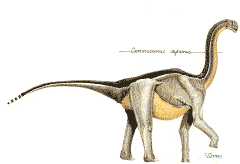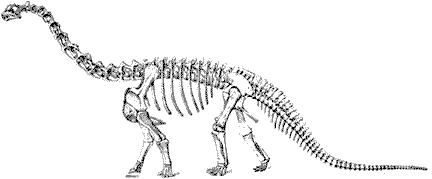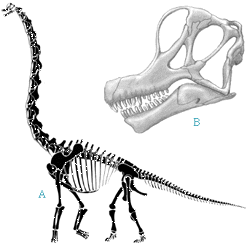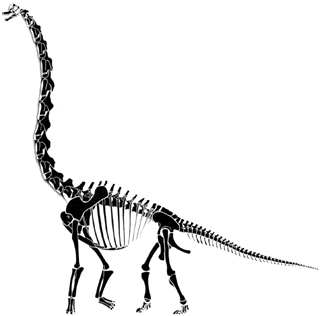
| Sauropodomorpha | ||
| The Vertebrates | Macronaria |
| Vertebrates Home | Vertebrate | Vertebrate |
|
Abbreviated Dendrogram
Dinosauria
├─Ornithischia
└─┬─Theropoda
│
└─Sauropodomorpha
├─Prosauropoda
└─Sauropoda
├─Cetiosauridae
└─Neosauropoda
├─Diplodocomorpha
│ ├─Rebbachisauridae
│ └─Diplodocidae
└─Macronaria
├─Camarasauridae
│ ├─Aragosaurus
│ └─┬─Lourinhasaurus
│ └─Camarasaurus
└─Titanosauriformes
├─Brachiosauridae
│ ├─Lapparentosaurus
│ └─┬─Atlasaurus
│ └─┬─Giraffatitan
│ ├─Bothriospondylus
│ ├─Pelorosaurus
│ ├─Cedarosaurus
│ ├─Sonorasaurus
│ └─┬─Sauroposeidon
│ └─Brachiosaurus
└─Somphospondylii
├─Euhelopodidae
└─Titanosauria
├─Nemegtosauridae
└─Titanosauridae
|
Contents
Index |
mJ-upK.
Introduction: Originally (especially in old books on dinosaurs) the brachiosaurs and camarosaurs were grouped together, with the diplodocids and titanosaurs as a seperate branch. Both brachiosaurs and camarosaurs have long forelimbs, shortish tails, short high skulls, and more and broader teeth. More recently research has shown that the titanosaurs are actually related to the brachiosaurs; the camarasaurs, brachiosaurs, and titanosaurs being collectively referred to as the clade Macronaria. (MAK 001201).
robust, spoon-shaped teeth; enlarged narial openings larger than orbits); crests formed by tall nasals; distal shafts of ischia plate-like and nearly coplanar; elongated metacarpals; Gondwanan origin;
Links: neosauropoda cladogram; macronaria; Untitled Document; ATW010210.
upJ of Eur & NAm, China(?), Aus(??).
Macronaria :: Titanosauriformes + * : Aragosaurus + (Lourinhasaurus + Camarasaurus)
 |
| Camarosaurus as it may have appeared in life. By Brenner Fishman |
Introduction: The camarasaurs are the most primitive of the Macronaria. However, they also are specialised in specific ways. The skull is short, blunt and relatively large. The teeth are large and spatulate or spoon-like. The neck very strong but inflexible, and apparently strongly upwardly-directed (an adaptation on browsing on trees, unlike the low-feeding diplodocids and euhelopids). A distinguishing mark is the "bifid" (split or two-branched) neural spines (i.e. the upward part of each vertebra is divided into two), the resulting U-shaped trough perhaps for the location of strong tendons. The forelimbs were not as elongated as in the brachiosaurids. The fore and hind legs are approximately the same length, the hind legs being only slightly longer. The tail is fairly short, relative to diplodocids. These animals appear to have lived in large herds.
Until fairly recently it was stated that Camarasaurus evolved from the Chinese Euhelopus, but it is more likely that the Chinese forms, with their extraordinarily elongated necks, represented a line of advanced Cetiosaurs. Despite their unspecialised structure, camarasaurs are not known before the early Kimmeridgian epoch, and it is possible that they evolved either from basal Oxfordian Brachiosaurids, or from early Jobaria-like forms. MAK 001201)
~18 m. Skull short, blunt and relatively large; teeth spatulate; teeth (Camarasaurus) show heavier wear than Diplodocus; short basipterygoid processes; jugal excluded from lower margin of skull (?); nares open laterally, just ant of orbits; cervical bracing (in Camarasaurus) by cervical ribs extending over 3 vertebrae; cervical vertebrae (12 in Camarasaurus) wide and short (neck very strong but inflexible); cervical & trunk vertebrae with extensive pleurocoels; vertical spines with U-shaped cleft (cleft on trunk only?); back horizontal (?); legs > arms, but not as marked as in Diplodocus; gastroliths known; most common dinosaur in J Morrison fm., perhaps all NAm.; mass death assemblage known (possible herding).
Links: DinoData: Camarasauridae; Geol 006 Sauropods; DinoData: Camarasaurus; Camarasaurus.
Range: Early Cretaceous of Europe
Phylogeny: Camarasauridae : (Lourinhasaurus + Camarasaurus) + *.
Introduction: Aragosaurus ischiaticus Sanz, Buscalioni, Casanovas, and Santafe, 1987
Age: early Barremian
Place: central Laurasia Spain)
remains: postcranial elements (forelimb, scapula, partial tail, and partial hip)
Length: 18 metres
Weight: 18 to 25 tonnes
Aragosaurus is very similiar to Camarasaurus. Aragosaurus is shown here as a primitive camarasaurid; but, in view of its later occurrence, may be a descendent of Camarasaurus. It is a very large animal, and shows that camarasaurids, although suffering local extinctions, happened to survive the terminal Jurassic event quite well. (MAK 001201).
Range: Late Jurassic of Europe.
Phylogeny: Camarasauridae :: Camarasaurus + *.
Introduction: Lourinhasaurus (Camarasaurus) alenquerensis deLapparent & Zbyszewski, 1957.
Horizon: Lourinhã Formation, Provincia do Estremadura and Provincia do Beira Litoral, Portugal
Age: early Kimmeridgian
remains: partial postcrania, tail vertebrae, teeth
estimated length: 17 metres
estimated mass: 15 to 20 tonnes
Previously mistaken for Apatosaurus, this giant sauropod was one of the first of the camarasaurids. This species, a robust, average camarasaurid, has recently been placed in a new genus, Lourinhasaurus. (MAK 001201).
 |
| Camarasaurus skeleton, total length 18 metres from the DINOSAURS AND THE HISTORY OF Life - GEOLOGY V1001x site. |
Range: Late Jurassic of North America
Phylogeny: Camarasauridae :: Lourinhasaurus + *.
Introduction: Camarasaurus grandis (Marsh 1877)
Synonyms: "Apatosaurus," Morosaurus, Pleurocoelus
Horizon: Morrison Formation; Wyoming, Colorado and Montana, United States
Age: Middle Kimmeridgian
Place: western Laurasia
remains: At least 6 partial skeletons, 2 with skulls; hundreds of postcranial elements
Length: 14 metres
Weight: 10 to 15 tonnes
Comments: a number of juveniles are known
Camarasaurus lentus (Marsh 1889)
Synonyms: Morosaurus, Uintasaurus
Horizon: Morrison Formation; Wyoming and Utah, United States
Age: Late Kimmeridgian
Place: western Laurasia
remains: 5 skeletons with skulls; hundreds of postcranial elements
Length: 14 metres
Weight: 10 to 15 tonnes
Comments: This animal was extremely common and dominated the megafauna of the region
Camarasaurus supremus Cope, 1877e
Horizon: Morrison Formation; Wyoming, Colorado and New Mexico
Age: Early Tithonian
Place: western Laurasia
remains: At least five partial skeletons
Length: 18 metres
Weight: 18 to 25 tonnes
Comments: The last and largest of the American camarasaurs. (MAK 001201)
Titanosauriformes: Titanosaurus + Brachiosaurus [R&F].
Range: from the Middle? Jurassic worldwide.
Phylogeny: Macronaria : Camarasauridae + * : Brachiosauridae + (Euhelopodidae + Titanosauria).
Characters: dental wear facets sharply inclined with respect to the labio-lingual axis; $ rodlike palatine - maxilla contact [R&F]; anterior dorsal ribs broad & plank-like [VN]; dorsal vertebrae with posterior centroparapophyseal laminae [S+05]; medial prespinal lamina in posterior trunk vertebrae; $ simple, undivided chevron blades [R&F]; caudal neural arches, anterior base implanted on centra [S+05]; blades of middle and caudal chevrons curve posteriorly and down [R&F$]; neural arches positioned anteriorly in mid and posterior caudal centra [VN]; distal condyle of metacarpal I undivided [VN]; claw on manual digit I reduced or absent; proximal 1/3rd of femur deflected medially [R&F$]; femur, lateral bulge below lesser trochanter [S+05][3];
Links: Ameghiniana Round Up, Pt. II (and so does Tom Holtz); The Journal of Vertebrate Paleontology; Sauropodomorphs October 1); Sauropodomorpha; Dinosaur Illustrated Magazine - DIM - number 001, 2001; Untitled Document; Nature Abstract; Phylogenetic Taxonomy of the Sauropoda (not strictly relevent, but interesting); paralititan.pdf; joël donnet Article 157; GEOL 104 Lecture 21- Sauropodomorpha- Size matters.
Rogers & Forster (2001) [R&F]; Salgado et al. (2005) [S+05]; Smith et al. (2001).
Note: [1] The characters marked "[VN]" show as strong, but not unambiguous, synapomorphies in an analysis I ran of essentially the [R&F] data set. The characters dealing with the ribs and Mt I are reversed in Rapetosaurus. The character relating to the caudal centra is reversed in Alamosaurus. [2] Note the interesting way in which the characters cluster. We might summarize this as: (a) the teeth and palate are redesigned to allow the teeth to shear past each other, (b) the distal forelimbs are simplified, and (c) the posterior balancing system is altered in a way which is not clear, but involves both stance and tail movements. [3] probably the same as the preceeding character. ATW051107.
mJ-mK of NAm, Eur, Mad & Afr.
Titanosauriformes : Somphospondylii + *: Lapparentosaurus + (Atlasaurus + (Giraffatitan + Bothriospondylus + Pelorosaurus + Cedarosaurus + Sonorasaurus + (Sauroposeidon + Brachiosaurus))).
Introduction: Together with the camarasaurs and titanosaurs, the brachiosaurs comprise clade Macronaria, one of the two main lineages of advanced sauropods. The brachiosaurs were a family of huge sauropods that includes some of the largest land animals. The brachiosaurs and their cousins, the camarasaurs, were distinguished by having forelimbs as long as or longer than their hind limbs, giving them high shoulders and a sloping back. This, and their long vertical necks, gave them a curiously giraffe-like appearance. They were high-grazers, able to feed on the leaves of trees too high for other sauropods to reach. They relied on sheer size as a defense against predators. The best-known species is the Tanzanian Giraffatitan more commonly known as Brachiosaurus), but many other species are also known. The brachiosaurids are the only dinosaurs with forelimbs consistently longer than the hind, hence the name "Brachiosaurus" - arm lizard.
 As with the camarasaurs the skull (right) is large compared with diplodocomorphs, the teeth long and spatulate (spoon-shaped). The upper front of the lightly-constructed skull (the nasal bones) is highly vaulted, with large, elevated nares (nostril holes) indicating nostrils close to the top of the head. This led to several bizarre theories. One was that the animal hid from predators at the bottom of deep lakes, feeding on water weeds and only poking its "snorkle" through the surface to breath. This is physiologically absurd, as water pressure would make breathing at such a depth impossible. The other theory is that brachiosaurs possessed an elephant-like trunk, as all mammals with trunks (tapirs, elephants, etc) have vaulted elevated nares. However, no reptile is known to have the facial muscles necessary for a trunk, and no indications of scars or blood vessels have been found in any dinosaur indicating a trunk-like organ. A more plausible theory is that the inflated nares were a cooling mechanism. Living during the tropical hothouse conditions of the Jurassic, such enormous animals were in danger of overheating. Blood therefore was conveyed to the top of the head, where it was cooled via heat-exchange and perhaps also membranes of skin (African elephants use their large ears for the same purpose - the frozen remains of woolly mammoths show their ears were a lot smaller).
As with the camarasaurs the skull (right) is large compared with diplodocomorphs, the teeth long and spatulate (spoon-shaped). The upper front of the lightly-constructed skull (the nasal bones) is highly vaulted, with large, elevated nares (nostril holes) indicating nostrils close to the top of the head. This led to several bizarre theories. One was that the animal hid from predators at the bottom of deep lakes, feeding on water weeds and only poking its "snorkle" through the surface to breath. This is physiologically absurd, as water pressure would make breathing at such a depth impossible. The other theory is that brachiosaurs possessed an elephant-like trunk, as all mammals with trunks (tapirs, elephants, etc) have vaulted elevated nares. However, no reptile is known to have the facial muscles necessary for a trunk, and no indications of scars or blood vessels have been found in any dinosaur indicating a trunk-like organ. A more plausible theory is that the inflated nares were a cooling mechanism. Living during the tropical hothouse conditions of the Jurassic, such enormous animals were in danger of overheating. Blood therefore was conveyed to the top of the head, where it was cooled via heat-exchange and perhaps also membranes of skin (African elephants use their large ears for the same purpose - the frozen remains of woolly mammoths show their ears were a lot smaller).
The neck was long and giraffe-like, with elongated individual vertebrae; the back also sloped in a giraffe-like fashion. These animals were, like the camarasaurs, high browsers, and may indeed have been able to reach even higher branches than the camarasaurids could. Unlike the camarasaurs, the neural spines of brachiosaurids were undivided and small. The neck, although large and stiff, was probably not equipped with the sort of powerful tendons camarasaurs had, and could not have been held as erectly. Most reconstructions are in error in that they show the neck held in a very high, camarasaur-like posture.
The non-zonal fibro-lamellar bone structure indicates fast, uninterrupted growth from the baby to the adult stage, and these animals were perhaps fairly metabolically active (another reason for the vaulted nares as a heat sink.
With average lengths of 18 to 25 metres, and usual adult weights 15 to 45 tonnes (the largest species reaching 30 to 35 meters in length and perhaps 60 to 80 tonnes in weight), the Brachiosaurs were the largest animals of their time. Like the elephants of today, they were lords everything they surveyed. Not even Ceratosaurs, Allosaurs, or Torvosaurs, the top predators of the Jurassic, would think of taking on a full-grown brachiosaur, any more than a lion would attack an adult elephant.
The phylogeny of brachiosaurids used here is a simplified version of the ones at Mikko's phylogeny site and Justin Tweet's Thescelosaurus! pages. I have also made the completely arbitrary assumption that the three species of Morrison Camarasaurs which suceed each other chronologically are also an evolutionary succession (a chronospecies so to speak). There are of course many more species than those listed in this diagram, but most of them are of questionable relationships.(MAK 010929)
Mass 20-90 T; if erect neck, 13 m; skull large and moderately long; teeth long & spatulate; vaulted nasal; large, elevated nares; neck vertically oriented (?); long neck with long individual vertebrae; long cervical ribs; neural spines undivided and usually small, especially in sacral region; deep pleurocoels in dorsal vertebrae; long slender dorsal ribs; tail short with simple chevrons; vertebral count 13+(11or 12)+5. forelimb at least as long as leg; metacarpals long; claw on manus I reduced or absent; center of gravity fairly far forward, so rearing unlikely (? controversial); non-zonal fibro-lamellar bone common (fast, uninterrupted growth).
Links: DinoData: Brachiosauridae; InfoBase: Setback pictures; WENCH - Dream star's Brachiosaurus; Brachiosaurus; DINOBASE, Sibbick's dinosaur pictures; Brachiosaurids; brachiosauridae; Brachiosaurus- Enchanted Learning Software; Brachiosaurus: The Natural History Museum's Dino Directory; BBC Online - Walking with Dinosaurs - Fact Files; Sauropodomorpha; Dino Land Paleontology Interviews: Matt Wedel; texas dinosaurs; Brachiosaurus many links); Lecture 14 - Late Jurassic: Morrison, Tendaguru; Brachiosauridae; Brachiosaurus; Brachiosaurus; Brachiosaurus; Prehistoric World Images - Brachiosaurus brancai - dinosaur art; BRACHIOSAURUS; Brachiosaurus by Kaiypodo; art.com - Brachiosaurus Dinosaurs Animals Posters/prints; DinoMania! - Le Brachiosaurus; Brachiosaurus. ATW021013.
Range: Middle Jurassic of Madagascar.
Phylogeny: Brachiosauridae : (Atlasaurus + (Giraffatitan + Bothriospondylus + Pelorosaurus + Cedarosaurus + Sonorasaurus + (Sauroposeidon + Brachiosaurus))) + *.
Lapparentosaurus madagascariensis Bonaparte, 1986b
Horizon: Isalo Formation, Majungar, Madagascar
Age: Bathonian
Place: central Gondwana
Length: 15 to 20 metres
Based on juvenile remains previously referred to the genus Bothriospondylus, this early species appears to be very similiar to, and perhaps a direct ancestor of Brachiosaurus. Like the approximately contemporary Atlasaurus, this is a Gondwanan form, and it is possible that the Brachiosaurs evolved in central Gondwana; China being dominated by Shunosaurine and Europe by Cetiosaurine Cetiosaurids. MAK 010929)
Atlasaurus: A. imelakei Monbaron et al., 1999
Range: Middle Jurassic Bathonian - Callovian) of Africa (Morocco)
Phylogeny: Brachiosauridae:: Giraffatitan + Bothriospondylus + Pelorosaurus + Cedarosaurus + Sonorasaurus + (Sauroposeidon + Brachiosaurus)) + *.
Atlasaurus imelakei Monbaron, Russell, and Taquet, 1999
Horizon:Guettious Sandstones, Beni Mellal, Morocco
Age: late Bathonian
Place:(northern central Gondwana)
Humerus 1.37 metres; femur 1.60 metres [Steel, p.64]
Overall length about: 13 to 14 meters
Comments: Originally called "Cetiosaurus" mogrebiensis, Atlasaurus imelakei is one of the earliest and most primitive of the brachiosaurids. MAK 010929).
Characters: skull large relative to Brachiosaurus [M+99]; $ supratemporal fenestra twice as wide as long & not visible in lateral perspective [M+99]; $ paroccipital processes extend horizontally at nearly right angles to long axis of skull [M+99]; basipterygoid process longer than other brachiosaurids [M+99]; $ mandibular symphysis and dentary very shallow [M+99]; dentary straight, not curving toward symphysis [M+99]; neck shorter than in Brachiosaurus [M+99]; 13+ cervical vertebrae [M+99]; cervical rib shafts slender and project beneath centra of following vertebrae [M+99]; probably 12 dorsal vertebrae [M+99]; ribs suggest narrower chest and body than in Brachiosaurus [M+99]; 5 sacral vertebrae, with sacrum not narrowing posteriorly (narrows in Brachiosaurus) [M+99]; tail long [M+99]; humerus 65 % of estimated length of dorsal series [M+99]; forelimbs unusually long [M+99]; $ ulna length > tibia length by about 115 % ?!) [M+99].
References: Monbaron et al. (1999) [M+99].
Range: Late Jurassic of Africa.
Phylogeny: Brachiosauridae ::: Bothriospondylus + Pelorosaurus + Cedarosaurus + Sonorasaurus + (Sauroposeidon + Brachiosaurus) + *.
Giraffatitan ("Brachiosaurus") brancai Janensch, 1914
Synonyms: Brachiosaurus brancai Janensch, 1914, Brachiosaurus fraasi Janensch, 1914
Horizon: Lower and Middle Saurian Bed, Tendaguru Beds, Mtwara, Tanzania
Age: Early to Middle Kimmeridgian
Place: Central Gondwana
remains: 5 partial skeltons, more than 3 skulls; altogether postcranial elements of at least 34 individuals
 |
size of selected skeletal elements
Left, a sketch of the famous Berlin Museum Brachiosaur; this is the tallest skeleton ever mounted. It is actually a composite of a number of specimens. Note - the position of the neck in this sketch is very unrealistic, the neck would actually have been held at a 45o angle image from Prof. Paul Olsen's Dinosaurs and the history of life - Geology V1001x site |
Overall Size of Complete Animal
| overall size (metres) | Overall Length | Shoulder Height | Head Height | Estimated weight (tonnes) |
| Fair-sized individual | 18 m | 14.9 t | ||
| Large individual [in Berlin Museum] |
22.2 m | 6.0 m | 14.0 m | 31.5 t |
| Very large individual [partial skeleton] |
25.0 m | 6.79 m | 18 m | 45 t |
Comments: Originally considered to be a species of Brachiosaurus, Giraffatitan is now generally placed in its own genus, although it may or may not be a subgenus of Brachiosaurus. It differs from the American Brachiosaurus altithorax in its more gracile build and different form of neck vertebrae. Most representations of Brachiosaurus are actually based on this species, which is known from more -- and more complete -- remains than any other brachiosaurid. It is a long-armed taxon based on a partial postcranium, and larger individuals are known. The skull has an unusually tall rounded crest containing the nostrils.
The Giraffatitan brachiosaurs were gigantic terrestrial herbivores, "giraffe-elephants" adapted to feeding on the crowns of trees. They dominated the Tendaguru megafauna, making up about 27% of all large animals (in terms of numbers of individuals identified in the Middle Saurian Bed), but in terms of actual biomass that figure would be closer to 78%. The large numbers would seem to indicate herding behaviour (like camarasaurs in the Morrison) The whole fauna could be rightfully called a Brachiosaur fauna. The only other identified sauropods were the small dicraeosaurs and Barosaurus, both in the vicinity of three to four and a half tonnes, and grasers upon low-lying and (in the case of Barosaurus) medium-height vegetation. MAK 010929).
Range: Late Jurassic of Europe and England.
Phylogeny: Brachiosauridae ::: Giraffatitan + Pelorosaurus + Cedarosaurus + Sonorasaurus + (Sauroposeidon + Brachiosaurus) + *.
Bothriospondylus suffosus Owen, 1875
Age: late Oxfordian-early Kimmeridgian
Place: European Islands (England and ?France)
Remains: back and hip verebrae
Length: 17.5 meters
Weight: around 17 tonnes, or possibly less
Comments: Not particularly well known, this sauropod appears to be closely related to Brachiosaurus. MAK 010929).
Pelorosaurus: P. conybearei Mantell, 1850 [nomen dubium]; P. becklessi Mantell, 1852 [nomen dubium]; "Cetiosaurus" humerocristatus Hulke, 1874 [nomen dubium]; "Dinodocus" mackesoni Owen, 1884; "Ornithopsis" leedsii Hulke, 1887 [nomen dubium].
Range: Early Cretaceous of Europe UK and Portugal) & North America(?).
Phylogeny: Brachiosauridae::: Giraffatitan + Bothriospondylus + Cedarosaurus + Sonorasaurus + (Sauroposeidon + Brachiosaurus) + *.
Characters: ~24m; humerus slim and fairly straight, with proximal expansion & well developed deltopectoral crest; another armored form?
Pelorosaurus conybearei Mantell, 1850
Synonyms: Pelerosaurus, Pelosaurus, Pelrorosaurus, Polorosaurus, Telorosaurus
Age: Barremian
Place: European Islands (England), Central Laurasia
Comments: known from assorted postcrania, and skin-impressions showing small, hexagon-like tubercles, Pelorosaurus a poorly known, fairly typical brachiosaurid, somewhat smaller than its Jurassic counterparts. A number of specimens assigned to this genus have been placed elsewhere, or are considered too fragmentary to identify properly. MAK 010929).
Links: DinoData PELOROSAURUS; Pelorosaurus Fact Sheet - EnchantedLearning.com; PELOROSAURUS; earlyimage; Pelorosaurus sp French); Synonyms of the species Pelorosaurus conybaerei; Nadine Solf's Dinosaurier-Datenbank German); On the presence of a sauropod dinosaur (Saurischia) in the Albian ...; . ATW030516.
Range: Early Cretaceous of North America.
Phylogeny: Brachiosauridae::: Giraffatitan + Bothriospondylus + Pelorosaurus + Sonorasaurus + (Sauroposeidon + Brachiosaurus) + *.
Cedarosaurus weiskopfae Tidwell, Carpenter, and Brooks, 1999
Horizon: Yellow Cat member of the Cedar Mountain Formation, Utah
Age: Barremian
Place: Western Laurasia Utah); Cashenranchian Fauna
Remains: partial skeleton.
Comments: Some material referred to Pleurocoelus (but not the type material) may belong here. "Pleurocoelus" (Hollow Side) is a name given to a number of smallish (8 or 10 meters) early Cretaceous American brachiosaurs known from the Arundal formation of Maryland. Astrodon (Star Tooth) is a synonym. Pleurocoelus altus was once thought to be the adult form of P. nanus, but more recently is has been suggested as an entirely different sauropod. The proportionately large pleurocoels of the Arundel type material is likely to be a juvenile trait; juvenile Camarasaurus material was once identified as Pleurocoelus because of the very large pleurocoels. It is likely that, like so many partial dinosaur remains, Pleurocoelus may eventually turn out to be invalid, i.e. nomen dubum (that is, it is sauropod and apparently brachiosaur but not complete enough to diagnose further) and may be assigned other genera. To confuse matters even further, it has recently been suggested that Cedarosaurus and some of the Pleurocoelus material is not even brachiosaurian, but titanosaur instead. MAK 010929).
Range: middle Cretaceous of North America
Phylogeny: Brachiosauridae::: Giraffatitan + Bothriospondylus + Pelorosaurus + Cedarosaurus + (Sauroposeidon + Brachiosaurus) + *.
Sonorasaurus thompsoni Ratkevich, 1998
Age: latest Albian
Place: Western Laurasia Arizona); Cashenranchian Fauna
remains: skull and partial skeleton
Length: length 14? to 17? meters
Comments: A "pygmy" brachiosaurid, this animal nevertheless shows strong similarities with its larger Jurassic cousins. MAK 010929).
Range: middle Cretaceous of North America.
Phylogeny: Brachiosauridae:::: Brachiosaurus + *.
Sauroposeidon proteles Wedel, Cifelli, and Sanders, 2000
Age: late Aptian-early Albian
Place: Western Laurasia Oklahoma); Cashenranchian Fauna
Remains: rib, cervical vertebrae
Length: 30 to 35 metres
Weight: around 60 to 80 tonnes
Comments: Currently holding the status of the largest dinosaur ever although the late Cretaceous titanosaur Argentinosaurus was certainly just as large), this enormous creature is known from four tree-trunk sized cervicals, and had the longest neck of any known animal, possibly twelve meters in length. It could have stood up to 18 meters tall. The drawing shows a comparison with a "standard" Brachiosaurus. MAK 010929).
Range: Late Jurassic of Europe & North America
Phylogeny: Brachiosauridae:::: Sauroposeidon + *.
Brachiosaurus atalaiensis Lapparent & Zbyszewski, 1957
Horizon: Unnamed unit, Provincia do Estremadura, Portugal
Age: Middle Kimmeridgian
Place: European Islands (Portugal)
Comments: The huge B. atalaiensis was probably a descendent of the earlier Kimmeridgian "Ornithopsis" leedsi. Like the contemporary Tendaguru Brachiosaurus Giraffititan) brancai this was a slender animal.
Brachiosaurus altithorax Riggs, 1903a
Horizon: Upper Morrison formation, Colorado and Utah
Age: Early Tithonian
Place: western Laurasia
Remains: two partial skeletons, also an old skull has recently been shown to belong to this species.
Length: 22 to 27 metres or more
Weight: 25 to 45 or 50 tonnes
Comments: A more heavily built species than the slightly earlier Giraffatitan, this species is similar, but less well known. Most restorations are actually based on Giraffatitan. This was one of the largest animals ever to live. The so-called "Ultrasaurus" and "Supersaurus" are actually based on partial remains of giant Brachiosaurs (in the case of Supersaurus mixed up with other species). B. altithorax did not seem to be as common as G. brancai, which may indicate a siolitary behaviour, in contrast to the herding Giraffititan. Alternatively, the rarety may be dues to local preservation and environmental factors; perhaps altithorax frequented areas taht were not conducive to fossilisation. MAK 010929).
Links:DinoData Dinosaurs B042 BRACHIOSAURUS; Brachiosaurus- Enchanted Learning Software as usual, excellent treatment disguised as a kid site); Brachiosaurus list of links); Brachiosaurus very basic); Brachiosaurus OK); BBC - Walking with Dinosaurs - Fact Files discussion); Dinosaur database - Brachiosaurus Danish); BRACHIOSAURUS basic data, but also references); Prehistoric World Images - Brachiosaurus brancai - dinosaur art image); Dinos' Home Page - Brachiosaurus Portuguese; basic discussion); Brachiosaurus and Ceratosaurus - Art.com, posters, prints and ... one of my favorite posters); National Museum of Natural History - Dinosaur Exhibits detail of humerus); DinoMania! - Le Brachiosaurus French, links to good discussion). ATW021226.
checked ATW051228